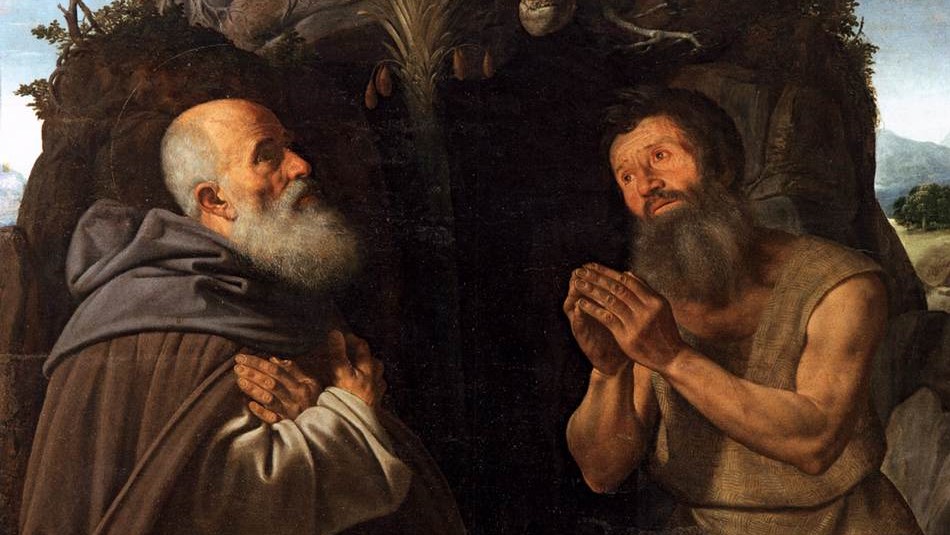

Deacon-structing Church Fathers: Desert Fathers
Deacon Pedro
Monday, June 14, 2021

Detail of St. Anthony Abbot and St. Paul by Girolamo Savoldo (Source: Wikimedia Commons)
Over the last couple of weeks we’ve been looking at the men whom the Church reveres as Church Fathers. Some of them are also considered Doctors of the Church, like Ambrose, Jerome, Augustine, Gregory the Great, Athanasius of Alexandria, Gregory of Nazianzus, Basil, and John Chrysostom. Others are not even considered saints, like Origen and Tertullian. It’s possible that you had heard of some, like Justin Martyr, Gregory of Nyssa, and Polycarp, but perhaps others, like Maximus the Confessor, Papias of Hierapolis, and Cyprian of Carthage were completely new to you.
In part 1, we looked at our Apostolic Fathers. In part 2, we looked at our Greek Fathers. In part 3, we looked at our Latin Fathers, and last week we looked at our Syriac Fathers. They are referred to by these names for the languages they wrote in.
Today let’s look at the last group, the Desert Fathers.
As you have probably deduced, the Desert Fathers are so called because they lived in the desert. They were monks, ascetics, or hermits who lived in the desert in Egypt in the third and fourth centuries. They are sometimes called "anchorites". That word refers to a person who lives in seclusion, usually for religious reasons. Two of the Desert Fathers are also recognized as Doctors of the Church. These are John Chrysostom and Athanasius. Both of them are also Greek Fathers.
There are several Desert Fathers. Most did not write much, but their contributions to our Tradition are great, in particular, contributions to modern monasticism. By the fourth century, thousands of monks and nuns had given up all their possessions and moved to the desert in order to seek solitude, following the example of the most well-known of our Desert Fathers, Anthony the Great.
But let’s begin with Paul of Thebes, who is credited as the first hermit to go into the desert.
According to St. Jerome, in his Life of Saint Paul the First Hermit, around 245 AD, Paul had to flee into the desert at age 16 when he was betrayed by his brother-in-law following the death of his parents. This same legend says that Paul lived in the desert until he was 113 years old. If you travel to Egypt today, near the Red Sea Mountains, in the Eastern Desert, you will find the Coptic Monastery of Saint Paul the Anchorite. This is believed to be the site of the cave where Paul lived and where he is buried.
Jerome also tells the story that Anthony the Great had a dream about Paul of Thebes and went into the desert to find him. They met when Paul was already 113 years old. They spoke for a day and broke bread together. The next day when Anthony went to find Paul again, he found him dead. Anthony clothed the body in a tunic that had been given to him by Athanasius and buried him.
Anthony the Great (251–356) is also known as Anthony of Egypt, Anthony of the Desert, Anthony of Thebes, Anthony the Abbot, and Anthony the Hermit. Most importantly, he is known as the “Father of All Monks”. Anthony’s biography was written by Athanasius of Alexandria. In it, Athanasius describes how Anthony became an ascetic after deciding to follow Jesus’ exhortation, “If you want to be perfect, go, sell your possessions and give to the poor, and you will have treasure in heaven. Then come, follow me” (Matthew 19:21). After fifteen years, Anthony still felt he needed to withdraw further, and this is when he went into the desert, where he remained for another 20 years. Over this time, those seeking to be his followers began gathering in caves and in tents nearby. At first, Anthony ignored their requests to see him, but eventually he relented and dedicated the next five years to teaching and organizing this large group of monks that had gathered around him. This is what earned him the title of “Father of Monasticism” and inspired similar communities to form in other places. He is often depicted in art as undergoing various temptations while living in the desert. His biography by Athanasius is the reason why Christian monasticism spread all throughout Western Europe.
Hilarion (291–371) is known as the Father of Palestinian monasticism. His biography was also written by St. Jerome, who was a contemporary. After studying in Alexandria, Hilarion converted to Christianity and returned to his home in the region near present-day Gaza where he settled to a life of simplicity in the desert. He also drew many followers and seekers, who followed him wherever he went. Eventually he moved to Sicily, then Dalmatia, and finally Cyprus, where he died.
Macarius of Egypt (c. 300–391) was a student of Anthony. Tradition says that before becoming an ascetic, Macarius was a smuggler of bath soaps. After living seven years as a hermit, Macarius met Anthony and learned from him the rules of monasticism. Afterwards, he became a priest and drew many followers into an eremitical community. Even though the monks all lived in separate cells, they followed the same rule and met for Divine Worship once a week.
Moses the Black (330–405) is also known as Moses the Ethiopian or Abba Moses the Robber. Tradition says that before becoming a Christian, Moses was a government official who was dismissed for theft and suspected murder. While hiding from authorities, Moses took refuge in a community of monks, who deeply influenced him to change his ways. Eventually, he became the abbot of the community and was ordained a priest.
Other Desert Fathers worth noting are Arsenius the Great, Poemen, Pachomius, Shenouda the Archimandrite, and Evagrius Ponticus. You may have also heard of John Cassian. Read about him in “Telling them Apart: So many Johns, part 2". You will also recognize Athanasius of Alexandria and John Chrysostom, who I mentioned above as Doctors of the Church.
It is to be noted that these men, particularly Anthony, Macarius, Hilarion, and Athanasius, were famous in their day. People flocked to see them and learn from their wisdom, as they did John the Baptist in the Gospels. I often wonder what that says of the people of the time – why were they so attracted to asceticism and lives of austerity and simplicity? Why aren't we?
Among the thousands that flocked to the desert to join these communities were also many women. Come back next week to learn about a few of them.
 Every week, Deacon Pedro takes a particular topic apart, not so much to explore or explain the subject to its fullness, but rather to provide insights that will deepen our understanding of the subject. And don’t worry, at the end of the day he always puts the pieces back together. There are no limits to deaconstructing: Write to him and ask any questions about the faith or Church teaching: [email protected]. Follow him on Facebook, Twitter and Instagram.
Every week, Deacon Pedro takes a particular topic apart, not so much to explore or explain the subject to its fullness, but rather to provide insights that will deepen our understanding of the subject. And don’t worry, at the end of the day he always puts the pieces back together. There are no limits to deaconstructing: Write to him and ask any questions about the faith or Church teaching: [email protected]. Follow him on Facebook, Twitter and Instagram.
 Every week, Deacon Pedro takes a particular topic apart, not so much to explore or explain the subject to its fullness, but rather to provide insights that will deepen our understanding of the subject. And don’t worry, at the end of the day he always puts the pieces back together. There are no limits to deaconstructing: Write to him and ask any questions about the faith or Church teaching: [email protected]. Follow him on Facebook, Twitter and Instagram.
Every week, Deacon Pedro takes a particular topic apart, not so much to explore or explain the subject to its fullness, but rather to provide insights that will deepen our understanding of the subject. And don’t worry, at the end of the day he always puts the pieces back together. There are no limits to deaconstructing: Write to him and ask any questions about the faith or Church teaching: [email protected]. Follow him on Facebook, Twitter and Instagram.Related Articles:
<<













